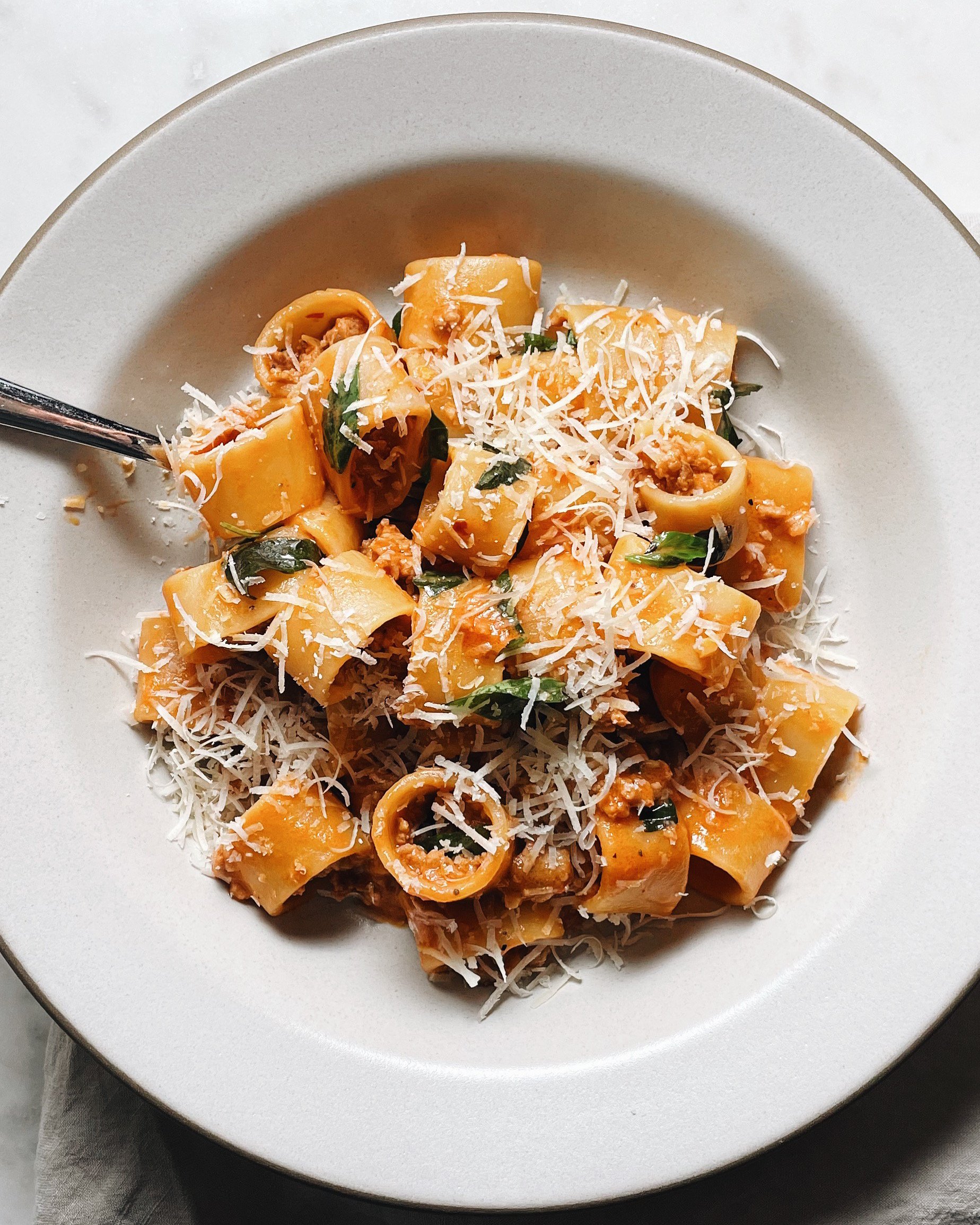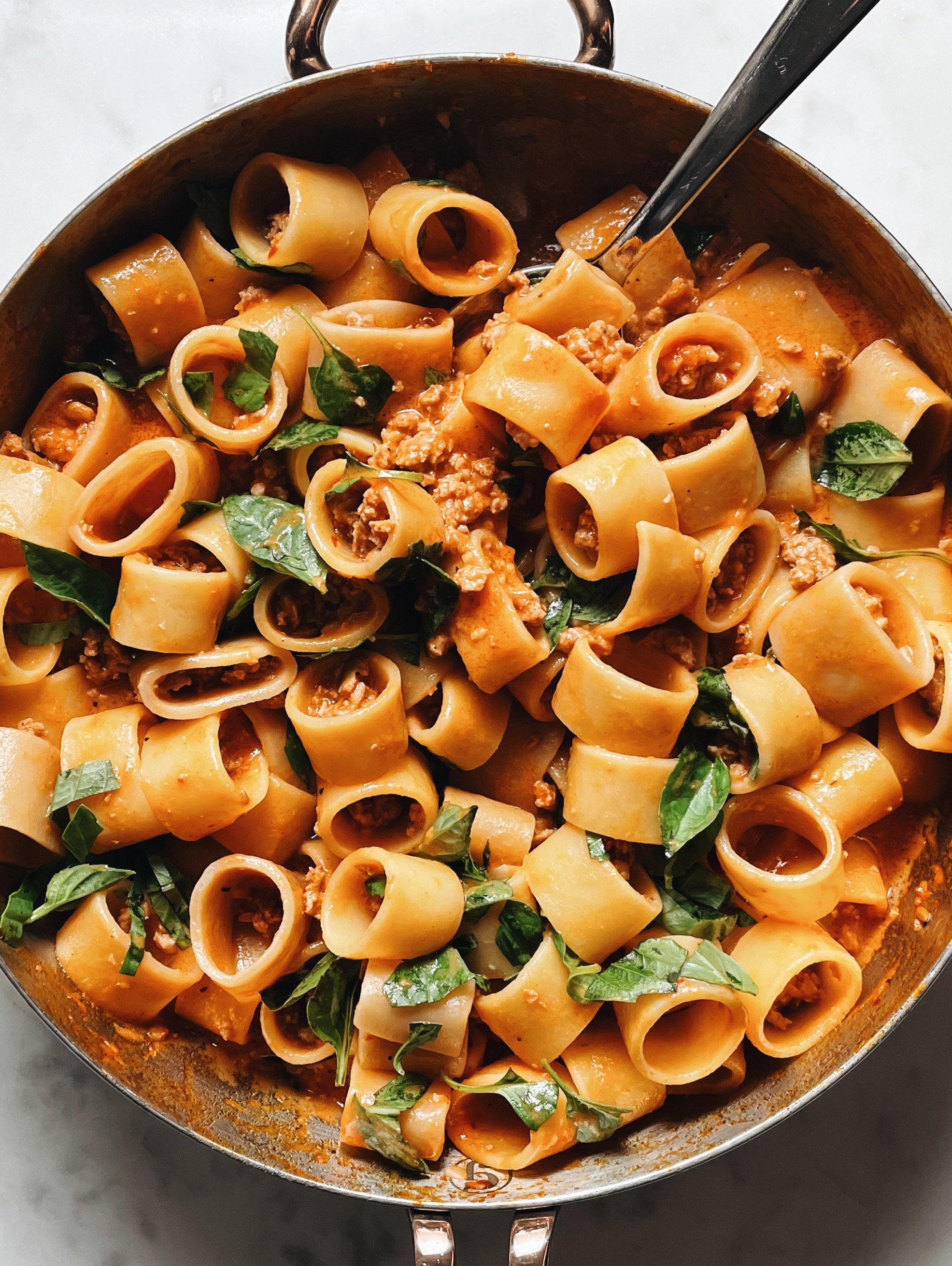summer friday sausage and basil sugo
Not that anybody’s TRULY trying to debate the difference between a sugo and ragù here, but in case you go to a lot of Italian restaurants and were wondering: the latter is a certain genre of meat sauce (of which bolognese is an even more specific sub-genre) and the former is just… a sauce. If bolognese is to ragù what a square is to a rectangle, then sugo is the biggest daddy rectangle of them all.
I originally wasn’t sure what to call this guy. Turns out, he’s been a sugo all along!
So how’d we then arrive at “Summer Friday” sugo? Because despite summer’s languid weather, it’s also weirdly the busiest season for everyone I know. By the time Friday afternoon rolls in my energy is mostly spent, my mental state ready to collapse like a dehydrated corn husk onto the fainting couch until the next morning (my mental state is, of course, very dramatic). But for this reason, you will not find me doing any kind of cutting, chopping, or mise en place engagement on Friday nights. Usually I just pout and pace the house until my boyfriend takes the hint to go pick up fried chicken. Summer Fridays, as we all know, aren’t supposed to feel like work—except when you do, in fact, have to work.
That said, sausage is a real godsend for Summer Fridays, because unlike other ground meats, sausage comes pre-loaded with all the flavors you’d typically have to chop to get on any other night: onion, fennel, herbs, etc. We do bother with the garlic, but you can just smash that if you want, or run it over the microplane. Just browning garlic and sausage and simmering it in tomato sauce is not really a recipe, though, so here we’re going just one mile extra and absolutely no further: simmering the sauce with basil stems (again, it’s summer) and a pat of butter, tearing up the leaves, and stirring in a sub-clinical amount of cream at the end—more for the nice orange color than anything else, although the texture gets a boost from it too.
Pasta water is predictably crucial to this recipe due to the small ingredient list. Make sure you save some.
For a real summer Friday vibe, pour a glass of chilled red wine while you cook, and enjoy the sweet serenity of knowing there’s none of it used in the recipe: it’s all for you.
recipe
Just a simple, low-maintenance everyday sauce with a little sausage, lots of garlic, and fresh torn basil.
Effortful time: 15 minutes
Total time: 1 hour
Makes enough sauce for 1 lb of pasta; pictured is calamarata (short calamari-shaped tubes)
you need
1 tbsp. olive oil
3/4 lb. mild Italian pork sausage, casings removed
4 cloves of garlic, peeled and smashed
1 tbsp. tomato paste
28 oz can crushed tomatoes
1 tbsp. butter
Kosher salt
Pinch of chili flakes
5-6 fresh basil stems and torn leaves, divided
2 tbsp. heavy cream, optional but recommended
Fresh grated parm, for serving
make it
Brown the sausage. Heat the olive oil in a deep skillet over medium-high heat. Add the un-cased sausage and brown, using a spatula to break it up into small pieces, until cooked through. This takes about 5-6 minutes.
Sauté the garlic. Turn the heat down to medium low. Scoot the sausage to the side of the pan so the oil pools in the empty space. Add the smashed garlic cloves and sauté until fragrant, about 2 minutes. Then stir to recombine with the sausage.
Add the tomato paste and crush into the oil, breaking up with the back of a spoon, about 30 more seconds.
Make the sauce. Pour in the passata, then add the butter, pinch of chili flakes, salt, and basil stems. Stir to combine, then turn the heat down to low, partially cover, and simmer 40 minutes. This is a good time to tear up your basil leaves.
Cook pasta. At the 30 minute mark, go ahead and boil water for pasta. Cook your pasta for 1 minute under the cook time on the package.
Finish and serve. 1 minute before that 1-min-under cook time, stir the cream into the sauce. Then transfer the pasta directly into the simmering sauce. Add a ladle full of pasta water to, you know, lubricate. Simmer until fully al dente. Remove from heat and gently stir in the fresh basil leaves. Serve with freshly grated parm and a drizzle of nice olive oil.

